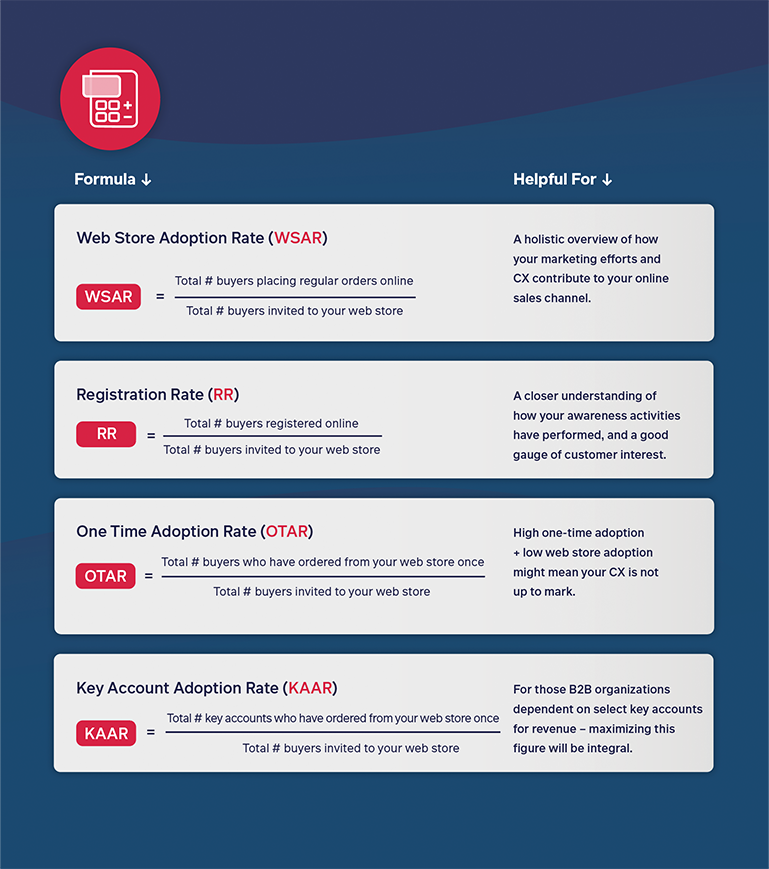Five Common Causes of Poor Web Store Adoption
B2B buyers today have high expectations from their vendor web stores. A desire for efficient, reliable, and convenient processes means that their online purchase experience needs to be seamless for them to choose it over another sales channel or competitor.
Order errors that arise from inaccurate information, an inability to access basic account information, and clunky UX all lead to buyer dissatisfaction. Poor web store adoption can therefore mean you’re at risk of your customers churning, especially if your commercial teams can’t accommodate their needs quicky.
The first step to trouble-shooting low adoption of your web store is identifying the reasons so many B2B buyers might be resistant to it. Below, you’ll find five of the most common reasons for poor B2B web store adoption:
1. Mainstream e-commerce solutions don’t meet B2B needs
Oftentimes, mainstream e-commerce solutions simply can’t cope with the needs of a B2B web store. Why? No real-time data available, a result of little to no integration with the ERP.
For most B2B organizations, the ERP is a source of truth that no web store can be built without. That’s because it contains the data for your ‘holy triangle’, i.e., your products, pricing, and customers.
Most e-commerce platforms therefore work by duplicating the data found in the ERP – a solution that gets messy fast, resulting in siloes between the two systems, and inaccurate data on your web store.
Integrating your ERP directly with your e-commerce platform is essential to web store accuracy, and therefore, adoption.
2. Unreliable information leads to broken trust
The relationship you have with your customers is built on a foundation of trust. This trust is strengthened with price transparency, quality assurance, and a clear commitment to seamless experience.
A buyer asked to switch their purchasing to your online channel, only to find an incorrectly listed price or discount, inaccurate stock levels, and an absence of trade agreements can understandably experience frustration.
Your chosen e-commerce platform plays a significant role here. To avoid compromising trust, it’s necessary to use tooling that will minimize data error and prioritize customer convenience.
3. Internal resistance results in lost opportunity
An ineffective web store might end up creating work for your commercial teams. Why? Inaccurate stock and pricing information (a result of no real-time updates) or inaccessible account information mean they end up troubleshooting issues that arise from a lack of real-time updates and poor customer experience on your web store.
Though your salespeople and customer service teams should be focused on strengthening relationships, they end up working as IT support. These issues create a natural distrust and resistance between your internal stakeholders and web store.
When this is the case, promotion of your web store is equally low. For your internal teams to become champions of your web store, it is necessary that you set it up to be an effective and helpful channel for them.
4. Absence of efficient goal setting to track progress
All too often, a B2B e-commerce project finds itself off the runway, in the air, and without a destination. Efficient goal setting is much like charting a flight – without course, your project will quickly lose momentum, and find itself drifting.
One of the main issues with goal setting around e-commerce projects is the absence of measurable and meaningful targets. Most organizations know they want their online sales channels to have high adoption rates, but few know exactly how to accomplish this.
Your e-commerce provider should be able to help you structure this, so you’re aware exactly how your investment is making impact.
5. Poor communication leaves customers disengaged
With so many contesting priorities driving the successful launch of an e-commerce project, it is perhaps understandable that customer onboarding might take a back seat.
The opposite needs to be true for high adoption. Getting your customers involved from the very start will ensure you have a web store that caters to their needs.
Qualitative and quantitative research in the form of surveys or interviews will ensure you have a complex understanding of their expectations and preferences.
This research ensures your customers feel involved in the process from the start, resulting in less resistance when it comes to migrating their purchase process. Adoption of a new platform without the correct training or communication can result in confusion and struggle very quickly, especially for customers used to traditional mediums.




